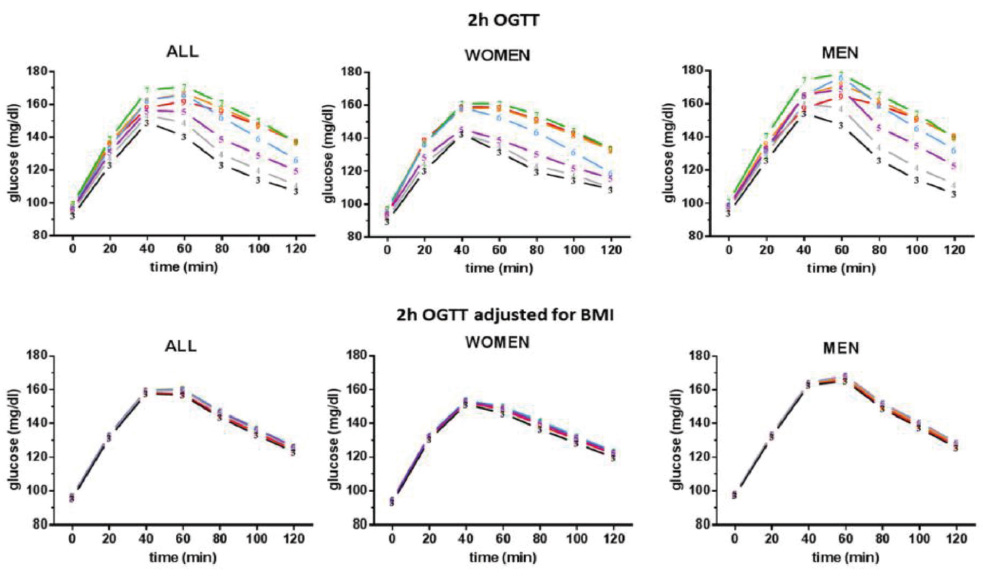J Korean Diabetes.
2019 Dec;20(4):215-219. 10.4093/jkd.2019.20.4.215.
Changes in Glucose Metabolism with Aging
- Affiliations
-
- 1Department of Internal Medicine, Hallym University Dongtan Sacred Heart Hospital, Hallym University School of Medicine, Hwaseong, Korea. hegletter@hallym.or.kr
- KMID: 2468008
- DOI: http://doi.org/10.4093/jkd.2019.20.4.215
Abstract
- The increasing risk of glucose intolerance and diabetes associated with aging is well established. However, it is difficult to determine whether changes in glucose metabolism result from biological aging itself or due to various environmental factors that occur during the aging process. Many epidemiologic studies have shown that plasma glucose levels after oral glucose tolerance test rise consecutively for every decade of age, but many of these studies also demonstrated the effects of environmental factors including obesity and exercise. In some studies, the development of insulin resistance and insulin secretion defects due to biological aging itself have also been identified as major etiologic factors of glucose intolerance. However, the rate of diabetes development due to these factors is expected to be very slow and largely preventable by addressing environmental risk factors.
MeSH Terms
Figure
Reference
-
1. Korean Diabetes Association. Diabetes fact sheet in Korea. updated 2018 May 14. Available from: https://www.diabetes.or.kr/pro/news/admin.php?category=A&code=admin&number=1546&mode=view.2. Meneilly GS. Pathophysiology of diabetes in older people. In : Sinclair A, Dunning T, Mañas LR, Munshi MN, editors. Diabetes in old age. 4th ed. Chichester, West Sussex, (UK): Wiley-Blackwell;2017. p. 15–24.3. Chia CW, Egan JM, Ferrucci L. Age-related changes in glucose metabolism, hyperglycemia, and cardiovascular risk. Circ Res. 2018; 123:886–904.
Article4. Scheen AJ. Diabetes mellitus in the elderly: insulin resistance and/or impaired insulin secretion? Diabetes Metab. 2005; 31 Spec No 2:5S27–5S34.
Article5. DeFronzo RA. Pathogenesis of type 2 diabetes mellitus. Med Clin North Am. 2004; 88:787–835. ix
Article6. Shimokata H, Muller DC, Fleg JL, Sorkin J, Ziemba AW, Andres R. Age as independent determinant of glucose tolerance. Diabetes. 1991; 40:44–51.
Article7. Muller DC, Elahi D, Tobin JD, Andres R. Insulin response during the oral glucose tolerance test: the role of age, sex, body fat and the pattern of fat distribution. Aging (Milano). 1996; 8:13–21.
Article8. Korean Diabetes Association. Diabetes. 3rd ed. Seoul: Korea Medicine;2018.9. Natali A, Toschi E, Camastra S, Gastaldelli A, Groop L, Ferrannini E. Determinants of postabsorptive endogenous glucose output in non-diabetic subjects. European Group for the Study of Insulin Resistance (EGIR). Diabetologia. 2000; 43:1266–1272.
Article10. DeFronzo RA. Lilly lecture 1987. The triumvirate: beta-cell, muscle, liver. A collusion responsible for NIDDM. Diabetes. 1988; 37:667–687.11. Winder WW, Hardie DG. AMP-activated protein kinase, a metabolic master switch: possible roles in type 2 diabetes. Am J Physiol. 1999; 277:E1–E10.12. Houmard JA, Weidner MD, Dolan PL, Leggett-Frazier N, Gavigan KE, Hickey MS, Tyndall GL, Zheng D, Alshami A, Dohm GL. Skeletal muscle GLUT4 protein concentration and aging in humans. Diabetes. 1995; 44:555–560.
Article13. Paolisso G, Ammendola S, Del Buono A, Gambardella A, Riondino M, Tagliamonte MR, Rizzo MR, Carella C, Varricchio M. Serum levels of insulin-like growth factor-I (IGF-I) and IGF-binding protein-3 in healthy centenarians: relationship with plasma leptin and lipid concentrations, insulin action, and cognitive function. J Clin Endocrinol Metab. 1997; 82:2204–2209.
Article14. Meneilly GS, Elliot T, Bryer-Ash M, Floras JS. Insulin-mediated increase in blood flow is impaired in the elderly. J Clin Endocrinol Metab. 1995; 80:1899–1903.
Article15. Ranganath L, Sedgwick I, Morgan L, Wright J, Marks V. The ageing entero-insular axis. Diabetologia. 1998; 41:1309–1313.
Article16. Meneilly GS, Ryan AS, Minaker KL, Elahi D. The effect of age and glycemic level on the response of the beta-cell to glucose-dependent insulinotropic polypeptide and peripheral tissue sensitivity to endogenously released insulin. J Clin Endocrinol Metab. 1998; 83:2925–2932.
Article


